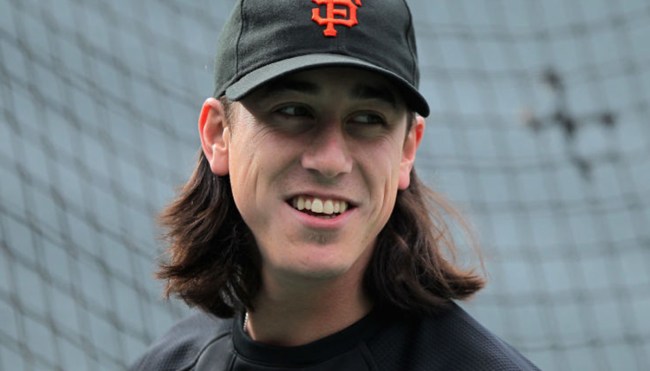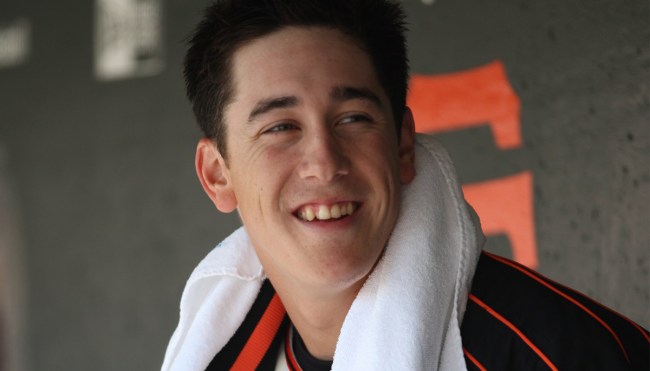
Getty Image
Tim Lincecum took Major League Baseball by storm in the early 2000s with his long locks, corky personality, and herky-jerky pitching motion. The 5-foot-11-inch righty was small in stature, but he shined on the mound, helping the San Francisco Giants take home three World Series titles.
In his prime, Lincecum was the game’s most feared pitcher. Nicknamed “The Freak,” he was a four-time All-Star, three-time strikeout king, and two-time Cy Young Award winner (he posted double-digit wins in all but three of his MLB seasons).
After quickly elevating through the minor league ranks, Lincecum cracked the Giants’ roster in 2007. He spent a decade on the West Coast, playing his first nine years in San Francisco before wrapping up a farewell tour in Los Angeles with the Angels.
Lincecum was a fascinating player to follow, and he won over the hearts of baseball fans alike due to his laid-back demeanor and unathletic appearance. I mean, how could you not fall in love with the Dazed and Confused lookalike? And for those who didn’t enjoy watching Lincecum on the bump (looking at you, Dodger fans), as Matthew McConaughey would say, “It’d be a lot cooler if you did.”
Hahaha Tim Lincecum and Mitch Kramer from Dazed and Confused look exactly alike. #picstitch pic.twitter.com/akW7LzFN
— Dylan Frye (@d_frye4) January 1, 2013
While his rise to fame was quick, his departure from professional baseball was equally as swift. He was forced out of the game prematurely due to a degenerative hip condition that forced Lincecum to officially hang up his cleats following the 2016 season.
So, what’s the former All-Star been up to since calling it quits? Let’s recap the lead-up to his decorated career before diving into what he’s up to these days.
Tim Lincecum’s Early Life And Career
Lincecum was born in Bellevue, Washington in 1984. His dad, Chris, played an integral part in his son’s baseball path. The elder Lincecum (who claimed he could still throw 88 MPH in his mid-50s) engineered the delivery that fans became so accustomed to seeing. From a young age, the family would tape Tim’s performances, analyzing and refining his pitching motion.
By the time he arrived at Liberty High School, Lincecum was well versed in pitching etiquette. Unfortunately, he stood at just 4’11” as a 14-year-old freshman.
Lincecum hit his high school growth spurt around his junior season, landing a spot on the varsity squad for his final two years. As a senior, the righty was named Gatorade Player of the Year in the state of Washington before being drafted by the Cubs in the 48th round of the 2003 MLB Draft. However, Lincecum spurned the offer from Chicago and instead opted to attend the University of Washington.
Between 2004 and 2006, Lincecum shined with the Huskies, going on to break the conference record with 491 career strikeouts. More impressively, he set the mark in just three seasons. As a freshman, he was named PAC-10 pitcher of the year. He went 10-3 that inaugural campaign, striking out 161 batters in 112.1 innings of work. Lincecum went 8-6 as a sophomore before again being named PAC-10 pitcher of the year as a junior.
That magical junior year saw the diminutive gunslinger win 12 games while posting an ERA of 1.94. Lincecum struck out 199 batters, earning All-America honors and landing the nation’s Golden Spikes Award given to college baseball’s most impressive performer. He is still the only player in program history to accomplish the feat. It was at this point in time that Lincecum was dubbed “The Freak.”
Following that phenomenal junior season, Lincecum was drafted 10th overall by the Giants in the 2006 MLB Draft. Opting to forego his final year of college eligibility, the righty inked a contract with San Francisco. His $2.025 million signing bonus was the most the organization had ever offered to an amateur player.
While that asking price may have seemed sky-high at the time, it was a move that paid off for the Giants shortly thereafter.
Lincecum made his minor league debut in 2006 with the Salem-Keizer Volcanoes before quickly being promoted to San Francisco’s Single-A squad in San Jose. He posted a 2-0 record between the two teams, striking out 58 batters in 31.2 innings. Another promotion would follow soon after.
Skipping Double-A completely, Lincecum made his way to the Triple-A level in 2007. Over the first month of the season, he posted a perfect 4-0 record with 46 strikeouts. Between ’06 and ’07, Lincecum struck out nearly 31% of the batters he faced. That would be the highest ratio of any minor league pitcher over the previous decade.
While he was experiencing unworldly success early in his professional career, he’d soon be on to bigger and even better things.
Tim Lincecum’s Time In The MLB

Getty Image
Lincecum was already considered to be the Giants’ top minor league prospect, and it was reflected by his pitching dominance. So, when starting pitcher Russ Ortiz went out of the lineup with elbow inflammation, it was Lincecum who was called upon to take his spot in the rotation.
And take that spot he did.
Lincecum appeared in 24 games that rookie season, posting a 7-5 overall record. The youngster struck out 150 hitters in 146.1 innings of work, impressing managers at the major league level. None, though, could’ve predicted how the next few seasons would unfold.
In his second year with San Francisco, Lincecum found himself squarely in the Giants’ starting rotation. Developing into a true staff ace, the righty notched career highs in starts, appearances, wins, strikeouts, and innings pitched. He led the majors 265 Ks, while recording an 18-5 mark on the bump.
That performance led to not only an All-Star invite but also an NL Cy Young Award at the end of the year. Not bad for his first full campaign in the MLB.
The following season was more of the same. He again led the league in strikeouts with 261. Lincecum won 15 games to land his second consecutive Cy Young Award. He was the first player in MLB history to accomplish the feat in each of his first two full seasons.
Shortly after the season’s end, Lincecum was pulled over for speeding, which later turned into a drug charge. The Giant pitcher was in possession of about three-and-a-half grams of marijuana, which was still illegal at the time of the stop.
Lincecum moved past the citation after that 2009 season, and soon would reach new heights.
The 2010 campaign led to Lincecum’s first postseason appearance. After winning the strikeout crown for a third straight year, the flame thrower helped guide the Giants to a World Series title. In his six playoff starts, Lincecum went 4-1 with an ERA of 2.43. He threw a complete-game shutout in a first-round win over the Braves. He was a perfect 2-0 in the World Series final against the Rangers.
Over those first four seasons at the major league level, Lincecum was 56-27 with 907 strikeouts. Everyone was taking notice of his All-Star abilities, and the pitcher was reaching fame and stardom across the sports world. He began appearing on magazine covers and being featured in commercials. It was the pinnacle of the career of Big Time Timmy Jim.
Tim Lincecum, "Big Time Timmy Jim" ESPN Commercial. https://t.co/ZlbHKxHDtw pic.twitter.com/XefSx8hNkM
— Rob Friedman (@PitchingNinja) December 5, 2017
Unfortunately, Lincecum’s time in the spotlight was soon coming to an abrupt end.
Over his final six seasons in the bigs, Lincecum posted four losing campaigns. He saw a significant decrease in velocity and skyrocketing ERAs. After recording an ERA of 4.00 or less in each of his first five seasons, he’d fail to match that mark any time between 2012 and 2016.
In 2012, Lincecum led the majors in losses and posted a 5.18 ERA. In his final year with the Angels, his ERA was over 9.00.
The fall from the top happened quickly and he was never able to achieve the success seen early in his career. Making things worse, the pitcher had season-ending hip surgery in 2015, his final year with the Giants. He signed a one-year deal with the Los Angeles Angels for the 2016 campaign, but that ended with a 2-6 record and demotion to minor league ball.
That last season in Los Angeles marked the end of Lincecum’s MLB career. He tried to make a run with the Texas Rangers in 2017 but never made it out of Triple-A. He hung up the cleats after that minor league season.
What Happened To Tim Lincecum After He Retired?

Getty Image
Lincecum ended his All-Star career with 110 wins, two no-hitters, and more than 1,700 strikeouts. He was one of the most beloved athletes in San Francisco sports history.
After retiring, though, he’s been able to stay out of the spotlight. He did return to Oracle Park in 2019 to celebrate the career of Giants’ manager Bruce Bochy at the skipper’s retirement ceremony, and in an interview with Amy Gutierrez, the pitcher said that he was still “trying to transition” to life after baseball.
Tim Lincecum came home and Giants fans erupted pic.twitter.com/XFAMh4OxzB
— Dalton Johnson (@DaltonJ_Johnson) September 29, 2019
He likely will never get into Cooperstown (though his name did make its debut in the Hall of Fame voting ballot this year), but Lincecum’s legend in Major League Baseball will always be safe.